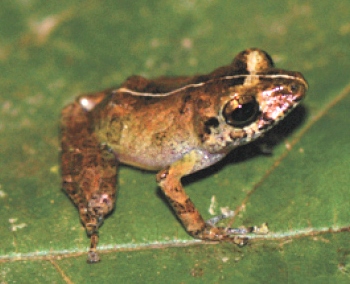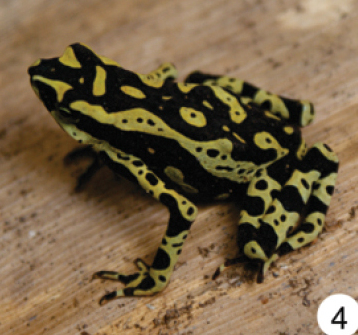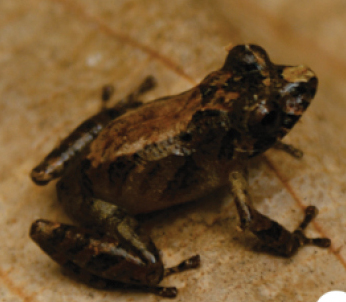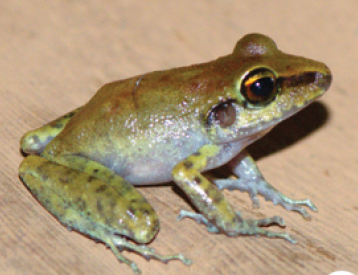Exploring the Marvelous World of Pristimantis marmoratus: The Marble Frog#
Among the lush jungles and vibrant ecosystems of Central and South America, a small yet captivating inhabitant leaps gracefully through the underbrush: Pristimantis marmoratus, commonly known as the marble frog. This intriguing species, with its rich patterns and elusive lifestyle, presents a fascinating glimpse into the complexity of amphibian life. As we delve into the world of Pristimantis marmoratus, we will uncover its captivating biology, unique behaviors, and the challenges it faces in an ever-changing environment. One particularly captivating fact about this species is its remarkable ability to adapt its color and pattern to blend seamlessly with its surroundings, an enchanting trait that makes it a master of camouflage.
Taxonomy and Classification#
Pristimantis marmoratus belongs to the family Craugastoridae, a group of frogs known for their direct development—bypassing the tadpole stage typical of many amphibians. Within this family, the genus Pristimantis encompasses a diverse array of species, highlighting the evolutionary wonders of frogs that have adapted to various terrestrial environments. The marble frog itself was first described in 1983, and though it is just one in a large family of over 300 species, its distinct features and behaviors set it apart from its closest relatives. Other members of the Pristimantis genus, often referred to as rain frogs or robbers, are known for their variable morphology and unique adaptations suitable for survival in their respective habitats.
Natural Habitat#
Nestled within the verdant realms of rainforest ecosystems, Pristimantis marmoratus thrives primarily in the moist, humid environments of the montane regions of Colombia and Ecuador. These frogs are typically found along the jungle floor, where they can hide among fallen leaves, moss-covered rocks, and the rich tapestry of organic material that covers the forest floor. Their preference for these specific habitats is tightly intertwined with their lifestyle; the dense underbrush offers protection from predators while providing ample opportunities for foraging. The interplay between the frog and its environment is an exquisite example of nature’s ingenuity; here, Pristimantis marmoratus demonstrates the delicate balance of life in a biodiverse ecosystem, relying on the myriad features of its surroundings for survival.
Physical Characteristics#
Measuring only around 2 to 3 inches in length, Pristimantis marmoratus boasts a striking appearance that is perfectly suited for its rainforest home. The species is characterized by its eye-catching marbled coloration, which varies significantly from one individual to another. These frogs typically display a blend of earth tones—greens, browns, and yellows—interspersed with darker mottled patterns. This intricate design not only provides aesthetic charm but serves as a critical survival adaptation through camouflage, blending seamlessly with the forest floor and deterring potential predators. Furthermore, their skin exhibits granular textures that may also play a role in moisture retention, facilitating their survival in a humid habitat.
Behavior and Life Cycle#
The feeding habits of Pristimantis marmoratus are as fascinating as their physical form. As nocturnal hunters, these frogs primarily feed on a diet of small insects and invertebrates, utilizing their keen sight and swift reflexes to capture prey. Their feeding strategy often involves ambush tactics, blending into their surroundings and waiting patiently for the right opportunity to strike. This behavior exemplifies the intricate predator-prey dynamics within their ecosystem, highlighting the frog’s role as both predator and prey.
When it comes to reproduction, Pristimantis marmoratus exhibits unique behaviors that differentiate it from many other amphibians. Instead of laying eggs in water, these frogs employ direct development, with the female laying eggs in moist leaf litter where they develop into miniature adults, bypassing the tadpole stage altogether. This adaptation not only minimizes the risks associated with aquatic predators but also allows the young frogs to be born directly into the forest floor’s protective embrace. The mating rituals of these frogs, characterized by melodious calls that resonate through the night, create a symphony of sound, echoing the vitality of the vibrant ecosystem.
Ecological Role#
As an integral player in its ecosystem, Pristimantis marmoratus occupies a niche that underscores its importance within the biodiversity of the rainforest. Acting as both predator and prey, the species contributes to the delicate balance of the rainforest food web. Frogs like Pristimantis marmoratus help control insect populations, preventing outbreaks that could have detrimental effects on plant communities. At the same time, these frogs serve as a food source for various predators, including snakes, birds, and even larger amphibians, promoting energy transfer and nutrient cycling within their habitat.
Threats and Conservation Status#
Despite its remarkable adaptations and ecological significance, Pristimantis marmoratus faces a myriad of threats that have raised concerns among conservationists and researchers alike. Habitat loss due to deforestation, agricultural expansion, and urban development poses one of the most significant risks to this species’ survival. Climate change further exacerbates these challenges, leading to altered precipitation patterns and rising temperatures that compromise the delicate balance of its rainforest habitat. Additionally, emerging infectious diseases, such as chytridiomycosis, have contributed to declines in amphibian populations globally.
Currently, the IUCN Red List classifies Pristimantis marmoratus as data deficient, indicating a pressing need for more comprehensive research to better understand its population trends and conservation status. In response, various initiatives are underway to protect the habitats where these frogs thrive. Conservation efforts aim to preserve critical rainforest ecosystems and restore areas that have been degraded, ensuring a sustainable future for Pristimantis marmoratus and its fellow inhabitants. These efforts underscore the importance of community engagement and education in fostering a sense of stewardship for one of the planet’s most biodiverse ecosystems.
Cultural and Scientific Significance#
Beyond the ecological narratives that surround Pristimantis marmoratus, this captivating frog also holds cultural significance within indigenous communities that inhabit its range. Often regarded as a symbol of vitality and resilience, frogs feature prominently in mythology and folklore, embodying themes of transformation and adaptability. They have also emerged as important indicators of environmental health, highlighting the fragility of ecosystems affected by human activity.
In scientific circles, studies involving Pristimantis marmoratus have led to remarkable discoveries, particularly concerning the evolutionary adaptations of frogs to terrestrial habitats. Researchers are interested in the unique toxins secreted by these amphibians, which could potentially lead to advances in pharmacology and medicine. Furthermore, the study of Pristimantis marmoratus contributes valuable insights into the effects of climate change on amphibian populations, allowing scientists to advocate for more comprehensive conservation measures.
Conclusion#
As we emerge from the depths of the rainforest to celebrate the life of Pristimantis marmoratus, we are reminded of the intricate connections that bind all living things within an ecosystem. This remarkable marble frog, with its vivid colors and unique adaptations, serves as both a symbol of the wonders of nature and a beacon of caution regarding the fragility of biodiversity. In an era where environmental challenges loom large, it is crucial to not only appreciate the beauty of such species but also to support the conservation efforts aimed at safeguarding their future. Whether it be through direct action, education, or advocacy, each one of us can play a part in preserving the delicate balance of our planet’s ecosystems. Together, we can ensure that enchanting creatures like Pristimantis marmoratus continue to thrive in the wild, captivating future generations with their beauty and resilience.
Learn more about the conservation efforts for amphibians
“`
This seamless narrative explores the captivating world of **Pristimantis marmoratus**, structured for engaging delivery on a WordPress site and formatted to enhance readability while embracing the beauty of storytelling intertwined with scientific accuracy.

















